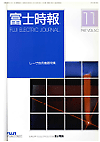FUJI ELECTRIC JOURNAL Vol.60-No.11 (Nov/1987)
 |
Applications of Laser Apparatus |
Technical Trends and Application Lasers
Masao Nakano
Along with rapid advance in laser technology, its application in metal working processes has widely spread mainly with YAG lasers and carbon dioxide lasers. It is expected that the number of laser-beam machines will be five times as many as the present one after five years making good use of respective features. The paper describes the advantages of the solid state lasers in comparison with the carbon dioxide lasers though several technical limits should be solved. Further, it suggests the countermeasures and expected applications.
On 100W YAG Laser Oscillators
Isao Kidokoro, Masayuki Niizuma, Takahiro Nagashima
Mainly 50W oscillators have been used for YAG laser markers. However, higher output oscillators were required sometimes and Fuji Electric has developed 100W oscillators. Though they are of multimode oscillation, the energy intensity distribution concentrates in the central part of the beam and the beam divergence angle is small, which lead to excellent marking performance. The paper introduces a model of high CW oscillation efficiency for laser soldering as well.
Laser Materials-Processing Technology
Seiji Imamura
Making good use of high energy density beam characteristics, laser-beam machining has been applied to various practical uses in recent years. This paper describes the trends of laser-beam machining utilizing the prevailing YAG lasers and carbon dioxide lasers. In particular, it presents an outline of new and promising laser materials-processing technology and its applications.
Fuji Laser Markers
Haruo Aoyama, Shin'ichi Orikasa, Susumu Ueda
The laser marking, one of laser applications being watched with keen interest, has achieved good results and is expected to be used more widely. Compared with usual marking, engraving, etching, printing, etc., it has superior capability of putting speedily clear, fine, and unerasable marks on any works by non-touch heating.
The paper introduces Fuji laser markers, LASERMATE series, classifying according to the laser types (CW pumped YAG, repetitively pulse pumped YAG, and TEA-CO2), and according to the marking methods (scanning method, mask pattern method), together with their principles, features, and applications.
The paper introduces Fuji laser markers, LASERMATE series, classifying according to the laser types (CW pumped YAG, repetitively pulse pumped YAG, and TEA-CO2), and according to the marking methods (scanning method, mask pattern method), together with their principles, features, and applications.
Laser Soldering Equipment
Haruo Aoyama, Nobuyuki Miyamoto, Hironori Kawamura
Together with recent rapid advance in electronics, parts mounting technology requires high density, miniaturization, and multifunction. For this purpose, Fuji Electric has developed and put on the market the laser soldering equipment, LASERMATE-SD, having merits such as spot heating, non-touch heating, high energy density, high operability, etc.
This paper introduces its outline, specification, construction, features, precautions, for use, and the applications. Particularly, it details the application examples to flat package ICs, i.e. popular electronic parts for surface mounting.
This paper introduces its outline, specification, construction, features, precautions, for use, and the applications. Particularly, it details the application examples to flat package ICs, i.e. popular electronic parts for surface mounting.
Power Supply for Lasers
Masayuki Niizuma, Kazuhiro Koie
The performance of laser oscillators greatly depends on that of their power supplies. The paper introduces the power supplies for various lasers which make the most of the latest laser technology and power electronics (for continuous excitation YAG lasers, pulsed excitation YAG lasers, glass lasers, argon lasers, and carbon dioxide lasers), and their circuits, features, characteristics, and so on.
A CAD and Control System for Laser-Beam Machining
Masahiro Miyoshi, Mitsuhiro Nakamura, Yasuyuki Shiromizu
Laser-beam machines utilizing larger output beams have come into wide use, which require improvements in operability, working factors, adaptability to FA, and so forth. To meet these requirements, Fuji Electric has developed a CAD and control system applicable to laser-beam machines aiming at the combined functions of CAD, control, communication, etc.
This system uses Fuji's industrial computer L25, and has such merits of adaptation and multifunction that one computer can perform CAD, machine control, communication, and transportation control in parallel.
This system uses Fuji's industrial computer L25, and has such merits of adaptation and multifunction that one computer can perform CAD, machine control, communication, and transportation control in parallel.

